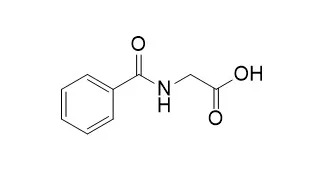| In vitro: |
| Xenobiotica, 1998, 28(5):527-537. | | Effect of diet on the urinary excretion of hippuric acid and other dietary-derived aromatics in rat. A complex interaction between diet, gut microflora and substrate specificity.[Reference: WebLink] |
METHODS AND RESULTS:
1. A combined in vivo and in vitro study has been devised to investigate an observation, obtained by 1H NMR of urine, that AlpfAp SD (Wistar derived) rats kept under standard husbandry conditions did not excrete urinary Hippuric acid (HA). meta-(hydroxyphenyl)propionic acid {m-HPPA} was identified as the major aromatic component inurine samples lacking HA. 2. Examination of urine from Alp:APfSD and Zücker (obese negative) rats fed various diets showed that the lack of HA/presence of m-HPPA was due to diet and not to the strain of animal.This observation was reinforced by the demonstration that the administration of benzoic acid (BA) to rats not previously excreting urinary HA resulted in the return of this component to the urinary excretion profile. Thus rats receiving the standard diet were still capable of glycine conjugation. 3. Changing the diet of rats excreting m -HPPA led to the cessation of m-HPPA excretion and the return of HA urine excretion. Interestingly, switching back to the original diet did not cause the loss of HA and the re-emergence of m-HPPA. 4. In vitro studies on the two enzyme systems responsible for glycine conjugation (benzoyl CoA:synthetase and benzoyl CoA:glycine N-acyltransferase) in isolated liver mitochondria showed that m-HPPA did not inhibit either enzyme. However, m-HPPA was not found to be a substrate for the first reaction step explaining why it was found in the urine as the free acid and not as a glycine conjugate. 5. The absence and presence of m-HPPA and Hippuric acid is suggested to be due to a combination of differences in dietary precursors of substrates for glycine conjugation and a dietary dependent redistribution of theintestinalmicroflora responsible for breakdownof plant phenolics and aromatic amino acids.
CONCLUSIONS:
Taken collectively this study emphasises how a simple diet change can cause a profound change in metabolism. | | Canadian Journal of Chemistry, 1975, 53(13):1993-2004. | | Reversible Inhibition of Carboxypeptidase A. IV. Inhibition of Specific Esterase Activity by Hippuric Acid and Related Species and other Amino Acid Derivatives and a Comparison with Substrate Inhibition.[Reference: WebLink] |
METHODS AND RESULTS:
The anions of each of the following carboxylic acids exhibit uncompetitive inhibition of the hydrolysis of O-hippuryl-L-3-phenyllactic acid by bovine carboxypeptidase A at pH 7.5, 25°, ionic strength 0.2: Hippuric acid, p-chloro- and p-nitroHippuric acids, hippurylglycine, carbobenzoxyglycine, phenaceturic acid, N'-(3-phenylpropanoyl)glycine, benzoxyacetic acid, 3-benzoylpropanoic acid, and O-hippuryl-D-mandelic acid. In each case, this uncompetitive inhibition is consistent with the ordered binding of substrate and inhibitor to the enzyme; i.e. the inhibitor binds to E.S but not to the free enzyme. Evidence is presented for the binding site for uncompetitive inhibitors being the same as for inhibitory ester substrate molecules. Comparison of the specificities of uncompetitive inhibitors and esters which display substrate inhibition provides evidence for a critical conformational change which controls the binding of uncompetitive inhibitors and inhibitory substrate molecules.D-Phenylalanine, D-leucine, D-p-nitrophenylalanine, glycyl-L-tyrosine, glycyl-L-phenylalanine, and glycyl-L-leucine are competitive inhibitors of the enzymic hydrolysis of O-hippuryl-L-3-phenyllactic acid, whereas the N-chloroacetyl derivatives of L-tyrosine, L-phenylalanine, and L-leucine are noncompetitive inhibitors. For the above D-amino acids, glycyl dipeptides, and N-chloroacetyl amino acids, the phenylalanine derivative in each case is a considerably stronger inhibitor than the corresponding leucine derivative. This preference is similar to that observed for the binding of peptide substrates but the reverse of that observed for ester substrates and simple mono- and dicarboxylate ion inhibitors.The peptide substrates carbobenzoxyglycylglycyl-L-phenylalanine and N-chloroacetyl-L-phenylalanine are noncompetitive inhibitors of the enzymic hydrolysis of O-hippuryl-L-3-phenyllactic acid.
CONCLUSIONS:
This clearly demonstrates the presence of different ester and peptide binding sites in this enzyme, which is consistent with conclusions from recent studies in other laboratories. | | Clin Chem Lab Med,2001 Mar;39(3):218-22. | | Hippuric Acid as a Modifier of Calcium Oxalate Crystallisation.[Pubmed: 11350018] | Hippuric acid (HA) originating from the conjugation of benzoic acid with glycine is a physiological component of human urine. Findings suggest that HA inhibits calcium oxalate (CaOx) growth and considerably enhances the CaOx solubility in artificial urine. Thus, it is assumed that HA is a major modifier of CaOx formation. However, only a slight CaOx growth inhibition of 1-8% was also reported. These values were also derived from artificial urine. The key mechanism, which led HA to be of interest in urolithiasis research is the fact that in presence of Ca2+ ions HA can form a hippurate complex. By forming such a complex, Ca2+ concentration in urine decreases, and as a consequence, CaOx formation is inhibited. This study was performed in order to clarify the role of HA in native and artificial urine.
METHODS AND RESULTS:
Biochemical analyses to calculate the relative CaOx supersaturations and crystallisation experiments using an in-line laser probe were examined. BONN Risk Indices indicating the risk of CaOx crystallisation were calculated from the results of the crystallisation experiments. The results obtained from artificial as well as from native urines showed that HA has no significant effects on CaOx formation.
CONCLUSIONS:
We suggest that HA plays only a minor role as a crystallisation modifier in human urine. |
|






 Cell. 2018 Jan 11;172(1-2):249-261.e12. doi: 10.1016/j.cell.2017.12.019.IF=36.216(2019)
Cell. 2018 Jan 11;172(1-2):249-261.e12. doi: 10.1016/j.cell.2017.12.019.IF=36.216(2019) Cell Metab. 2020 Mar 3;31(3):534-548.e5. doi: 10.1016/j.cmet.2020.01.002.IF=22.415(2019)
Cell Metab. 2020 Mar 3;31(3):534-548.e5. doi: 10.1016/j.cmet.2020.01.002.IF=22.415(2019) Mol Cell. 2017 Nov 16;68(4):673-685.e6. doi: 10.1016/j.molcel.2017.10.022.IF=14.548(2019)
Mol Cell. 2017 Nov 16;68(4):673-685.e6. doi: 10.1016/j.molcel.2017.10.022.IF=14.548(2019)